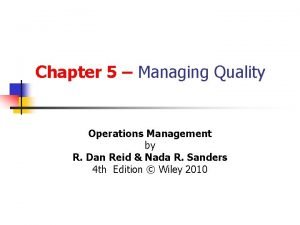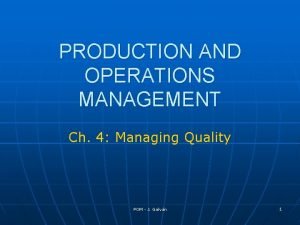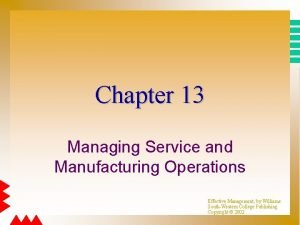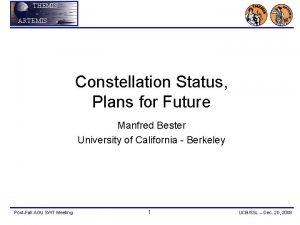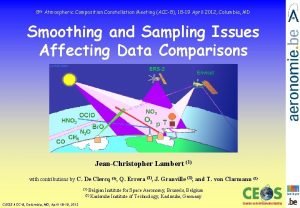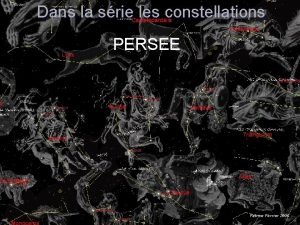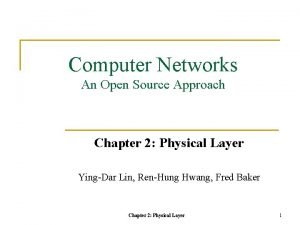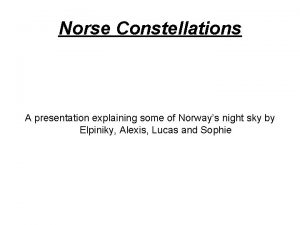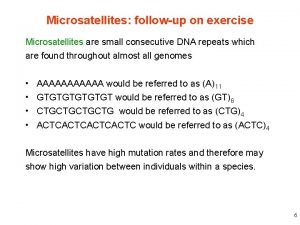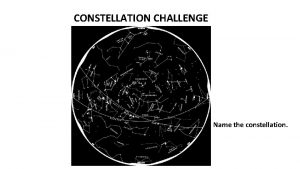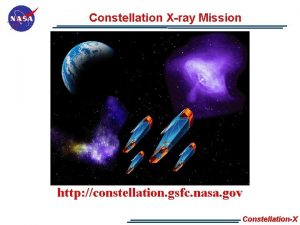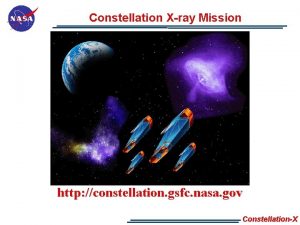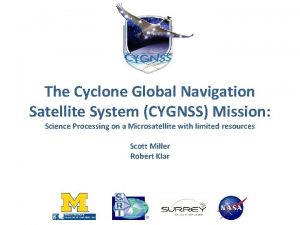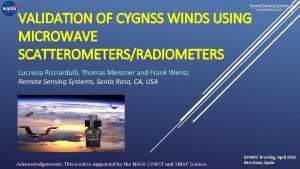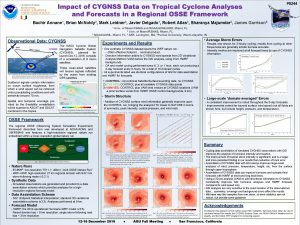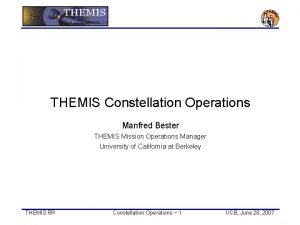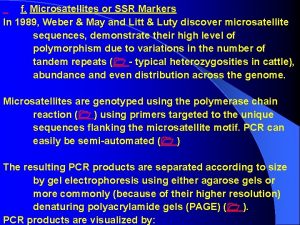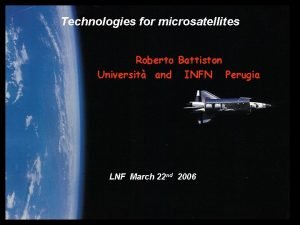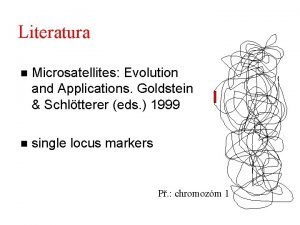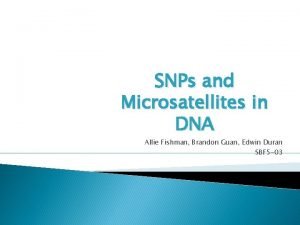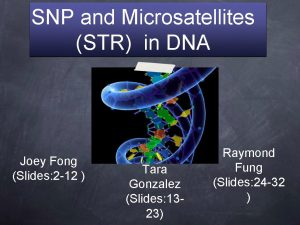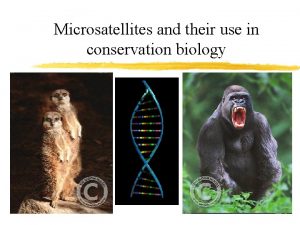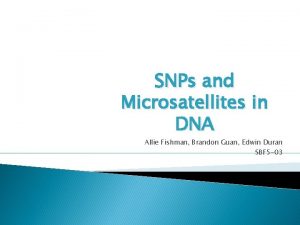CYGNSS Operations Managing a Constellation of 8 Microsatellites






















- Slides: 22

CYGNSS Operations: Managing a Constellation of 8 Micro-satellites in Low Earth Orbit Jillian Redfern Southwest Research Institute Improving Space Operations Workshop

Outline • • CYGNSS Mission CYGNSS Operations – Launch and Early Orbit – Mission Planning – Command Control – Data Processing – Automation 2

CYGNSS Science Advancements ® Prior to CYGNSS: – Track forecasts vs. intensity forecasts – Current intensity measurements Hurricane Hunter (WC-130 J Aircraft) Measurement made “Hurricane Hunter” aircraft – Current spacecraft measurements attenuated by rain ® Eight satellites provide near gap-free coverage in 24 hours – <30 kg each ® Storm revisit time is less than 6 hours CYGNSS 24 -Hour Coverage Map 3

4

Launch and Early Operations • Launched December 15, 2016 – Second attempt • Two 13 -hour shifts for initial two weeks • Sw. RI: December 2016 – Pegasus Rocket on L-1011 – First Built Satellite[s] – First Mission Operations Center 5

Commissioning • Original Plan: Nadir in 4 days – Ended up being 1. 5 months • Flexibility and Automation were key – Unstaffed contacts – Unique idle pattern with Automatic Playback even in Safe Mode – Fault Detection and Correction Onboard • CYGNSS satellites are all slightly unique – But on the whole they are extremely similar 6

Original Operations Concept • 48 Hour Cadence Between contacts for each satellite – Data downlink is Automatic • Nominal science data always recording once enabled unless a safing event occurs • No Propulsion • High Drag Maneuvers to Configure Constellation • Minimal daily tasking needed for Operations • Command Uploads at 1/week cadence with 2 week duration • One Science Pointing Mode: Nadir 7

Updated Operations Concept • 24 Hour Cadence Between contacts for each satellite – Data downlink is Automatic • High Drag Maneuvers only to avoid collision • Frequent activity updates from SOC for additional science (Active Storms, Flooding, Calibration) • Command Uploads at 1 -3/week cadence with 2 week duration • One Science Pointing Mode: Nadir (with 90 deg Yaw for Calibration)

Mission Planning • Special Science Requests – Additional Data taken over Tropical Cyclones in concert with NOAA hurricane plane flights • MOC/Engineering Requests – Radiation Effects – Updating Onboard Macros • Flight Dynamics – Collision Avoidance – Constellation Configuration • Recovery After a Safing Event – 1 -2 days; Additional 2 -3 passes depending upon cause – Ground-based automatic data downlink around the event 9

Mission Planning Calendar 10

Planning Information Flow 11

SIMPL 12

Command Control • Galaxy – Hammers Company Command Telemetry System – CCSDS Compliant Satellite Command/Control and Telemetry Processing System – Fleet Context utilized by CYGNSS • Common Database with differences incorporated • Allows for simultaneous, single sourced contacts – Telemetry Limit Checking in Real-Time and Post-Pass • USN (SSC Space US) – Five Ground Stations in Hawaii, Australia, and Chile • Allows for simultaneous contacts for better downlink coverage 13

Real-Time Data Flow 14

Data Processing 15

DP Procedure • Raw data files arrive from SSC • Delivered to Data Processing machine (one per satellite) • Python functions process data to find gaps and remove header data • CCSDS packet file is created for delivery to the SOC • Limit Violations Reports Created • ASCII Export of Crucial Data for Mission Planning and Flight Dynamics created • All Products Archived 16

Automation • Mercury • RTS • Schedule Executor • Python Data Processing – – – Delivers, Tracks, and Archives all of the MOC products Start Programs Mission Planning Products, Command Uploads, Data Processing Products – – – 63 Real Time Sequences Onboard Fully Configurable Allows for single command execution to execute multiple timed commands Fault Detection and Correction Automatic Playback of Data during Contacts – Executes Commands or STOL Procedures at a given time – Finds gaps and automatically replays any missing block of data more than 0. 5% 17

Additional Information • Data (Level 1, 2, 3): https: //podaac. jpl. nasa. gov/CYGNSS • PI Institution: http: //cygnss-michigan. org • NASA website: https: //www. nasa. gov/cygnss 18

CYGNSS Data From Flight (v 1. 1 calibration is still preliminary) 19

Soil Moisture Applications

Conclusions • All 8 satellites are operating nominally • Atlantic Hurricane Season keeps MOC and SOC busy from August – November • Flooding/Tides/Thaw-Cycle keeps the MOC and SOC budy the rest of the time 21

ANY QUESTIONS? 22
 Managing service and manufacturing operations
Managing service and manufacturing operations F&b cycle
F&b cycle Managing front office operations 10th edition
Managing front office operations 10th edition Managing quality in operations management
Managing quality in operations management Managing quality in operations management
Managing quality in operations management Managing service and manufacturing operations
Managing service and manufacturing operations Managing quality in operations management
Managing quality in operations management Smallest constellation
Smallest constellation Artemis constellation
Artemis constellation Imaginary constellation
Imaginary constellation Current gps constellation
Current gps constellation Constellation confusion worksheet
Constellation confusion worksheet Constellation space suit
Constellation space suit Mazzaroth
Mazzaroth Acc8
Acc8 Adlerian
Adlerian Hamlet characters
Hamlet characters Constellation de persée
Constellation de persée Ask modulation constellation diagram
Ask modulation constellation diagram Constellation
Constellation Orion mythologie représentation
Orion mythologie représentation Viking constellations
Viking constellations Star constellation schema
Star constellation schema



